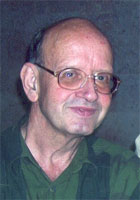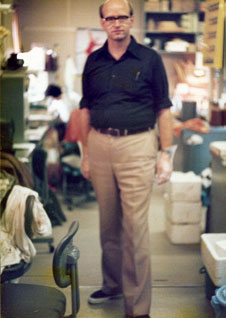Wolfram Ostertag
Interview

He was just 21 years old, when he published his first article in the well-known US-magazine „Science". With this article the career of Wolfram Ostertag, who had been born on 7th of December 1937 in Ludwigsburg (Württemberg), started. The German scientist, who is one of the fathers of the gene therapy, became known international, when he described the anti-retroviral characteristics of AZT (Azidothymidin) in 1974. The Max-Planck Society, for which Ostertag worked at that time in the Göttinger Institut for Experimental Medicine, did not apply for a patent for this description. Thirteen years later the US Federal Drug Authority (FDA) permitted the use of AZT to treat Aids – on request of the patentee, the (former) US-company Wellcome. It was the first drug against the Retrovirus HIV. Even this procedure annoys him still, Ostertag could not be discouraged, he continued to research consistently – in order to achieve his goal: a safe gene therapy to relieve human illnesses. Now he lives – after an eventful life – in the north of Hamburg.

„The idea of the gene therapy fascinated me already as an upper stage pupil. At that time I drove from Ludwigsburg to Stuttgart, because there was a library with specialist books concerning biology and genetics. I discovered the book of a Russian scientist, who speculated about the possibilities to change the human genotype by gene therapy", Ostertag tells. Since that time he knew: He wanted to study natural sciences, he wanted to investigate the life in the laboratory. His hole life, he says, he has been more interested in experiments than in pure "thought games". Nonetheless he took unorthodox paths with his often brilliant experiments - and he always paid attention to the ethical questions of his work. „A germline therapy is ridiculous and humans shouldn't be cloned. There is no reason for doing that ", emphasizes Ostertag and refers to the fact, that the evolution needs genetic variety.
In 1956 the curious young man registered first at the University of Mainz for biology, chemistry and physics. Two years later he went to the USA. At the Indiana University in Bloomington he continued his studies – and teached already anthropology. He worked with the Nobel prize-winner H.J. Muller. In 1958 he finished his study with the Bachelor – and his first publication in „Science ". Muller shaped him, he encouraged him to be to tolerant and friendly, remembers Ostertag, who is still a modest scientist. Till now he prefers laboratory-work to public events or writing articles.
The following three years Ostertag got a scholarship financed by the National Institutes of Health (NIH). His graduation over „The genetic basis of somatic damage produced by radiation into third instar larvae of Drosophila more melanogaster " was printed in „Science " – followed by 231 publications until today.
„I wanted to work in the human genetics ", says Ostertag retrospectively. This desire led him to the University of Münster, because he could get a Postdoc job in genetics. In Münster he came to know his wife, the couple has three children.
At the age of 28 years the scientist, who knows „simply by intuition" what has to be done, habilitated. Now he has a rich knowledge over chemical Mutagenesis in cell cultures. Again and again he examined the effect of Coffin. Whether it was the stimulating effect of this drug, or simply his almost insatiable curiosity – 1966 Ostertag left Germany again, in order to work at the well-known John Hopkins University (Baltimore). It was quite easy for me, to get a job there, remembers Ostertag. Günter von Ehrenstein gave a guest-lecture in Münster, and Ostertag introduced himself to von Ehrenberg, who immediately invited him to the USA. So easy life can be.
At the John Hopkins University he discovered that system of the human body, that fascinated him during all his scientific carreer: the blood-system. When von Ehrenstein became Honorary Professor at the Max-Planck Institute (MPI) for Experimental Medicine in Göttingen in 1968, Ostertag followed him. At the MPI Ostertag described for the first time, how embryonic haemoglobine are formed. And he got first impressions in the life circle of retroviruses. Using this knowledge Ostertag created – still in Germany - the first "taxis ", which can transfer genes into a cell.
After the US-scientists Stanley Cohen (Stanfort University) and Herbert Boyen (University of California) discovered in 1973 „the sewing machine ", with which genes of different species can be joined, and the discoveries of Ostertag and others, the way to manipulate genes was free. The age of biotechnology started - and with it the age of the large ethical questions like: What are humans allow to do? For Ostertag the answer is clear: Research.

Exactly that is, what the pioneer of the gene therapy, who is interested in new generation of scientist and in art as well, does. In the centre of his work, which he performed from 1978 to 1981 at the Beaston Institute for Cancer Research in Glasgow (Scotland), were oncogenes and growth factors as parts of retrovirus-vectors for e gene transfer into embryonic and haematopoietic cells. His goal: To design taxis in a way, that the vectors deliver their goods exact and only to that place in the genom, where new genes are needed.
While Ostertag planned carefully one experiment after the other, not promising quick success in this new field of research, quiete a number of scientists track attentions to themselves with large welfare promises. In 1980 the first successful gene therapy was carried out – in the same year Ostertag moved on invitation of Rudi Jaenisch (today at the Massachusetts Institute of Technology, Boston) from Scotland to Hamburg. He joined the team of the Heinrich Pette Institute (HPI), which belongs to the Universitätsklinik Hamburg Eppendorf (UKE). 22 years Ostertag led the department for cell-und virus-genetics, from 1995 to 1998 he was director of the HPI. Systematically it optimised the techniques of the somatic gene therapy – when in 1999 in the USA the GAU of gene therapy happened. A 19 years old boy died at the consequences of the interference in his genom.
The investigation by the FDA showed that several clinical tests did not run in accordance with the regulations. „We warned the colleagues at that time that their gene-taxis were not at all sufficiently tested. But nobody heard on us ", says Ostertag, who has no doubt, that this therapy form will be established. „We know simply still not enough."
Therefore Ostertag, who confers emeritus status on the 31st of December 2002, works today as a Honorary Professor at the Medical University of Hannover. There he met one of the leading experts on gene-therapy, Prof. Christoph Baum, they know each other from the HPI. In experiments with mouse cells Ostertag tries to find out, how researchers can manipulate embryonic stemcells by gene-taxis in a way, that this cells can be used for the therapy of illnesses of the blood system. He wants to realize his dream from a therapy, that is custom-made for each patient and is side effect-free as far as possible.
His knowledge Ostertag does not only publish in well-known magazines. With his knowledge he created also three companies: "EUFETS" in Idar Oberstein, "Cell Tech" and "VISION 7" in Hamburg. And he passes his knowledge on to young researchers, for example in the context of the Wilsede Meetings, on which he was frequently guest.
Hamburg, den 12. Januar 2007, Angela Grosse
Curriculum Vitae
english version coming soon
Publications
Selected Publications with complete content
- Kuhlmann, W., Fromme, H.G., Heege, E.H., and Ostertag, W.: The mutagenic action of caffeine in higher organisms. Cancer Res. 28, 2315-2389 (1968).
- Ostertag, W., Melderis, H., Steinheider, G., Kluge, N., and Dube, S.K.: Synthesis of mouse hemoglobin and globin mRNA in leukaemic cell cultures. Nature 239, 231-234 (1972).
- Weimann, B.J., Kluge, N., Cole, T., Dube, S.K., v. Ehrenstein, G., Gaedicke, G., Kind, J., Knebel, A., Krieg, J.C., Melderis, H., and Ostertag, W.: Differentiation and transformation of hemapoietic cells in culture. In: Modern Trends in Human Leukemia (R. Neth, R. Gallo, F. Stohlman, and S. Spiegelman, eds), pp. 84-93. Grune and Stratton, New York, 1974.
- Dube, S.K., Pragnell, I.B., Kluge, N., Gaedicke, G., Steinheider, G., and Ostertag, W.: Induction of endogenous and of spleen focus forming virus during DMSO induced differentiation of spleen focus forming virus transformed cells. Proc. Natl. Acad. Sci. USA 72, 1863-1867 (1975).
- Steinheider, G., Melderis, H., and Ostertag, W.: Embryonic a chains of mice and rabbits. Nature 257, 714-716 (1975).
- Stocking, C., Löliger, C., Kawai, M., Suciu, S., Gough, N., and Ostertag, W.: Identification of genes involved in growth autonomy of hematopoietic cells by analysis of factor-independent mutants. Cell 53, 869-879 (1988).
- Grez, M., Akgün, E., Hilberg, F., and Ostertag, W.: Embryonic stem cell virus, a recombinant murine retrovirus with expression in embryonic stem cells. Proc. Natl. Acad. Sci. USA 87, 9202-9206 (1990).
- Dube, S.K., and Ostertag, W.: AZT before AIDS. Nature 352, 114 (1991).
- Stocking, C., Grez, M., and Ostertag, W.: Regulation of retrovirus infection and expression in embryonic and hematopoietic stem cells. In: Symposium "Virus Strategies" (W. Doerfler, ed.), Verlag Chemie, Weinheim, 433-455 (1993).
- Eckert, H.G., Stockschläder, M., Just, U., Hegewisch-Becker, S., Grez, M., Zander, A., Ostertag, W., and Baum, C.: High-dose multidrug resistance in primary human hematopoietic progenitor cells tranduced with optimized retroviral vectors. Blood 88, 3407-3415 (1996).
- Laker, C., Meyer, J., Schopen, A., Friel, J., Heberlein, C., Ostertag, W. and Stocking, C.: Host cis-Mediated Extinction of a Retrovirus Permissive for Expression in Embryonal Stem Cells during Differentiation. J.Virol. 72, 339-348, (1998)
- Schiedlmeier, B., Klump, H., Will, E., Arman-Kalcek, G., Li, Z., Wang, Z., Rimek, A., Friel, J., Baum, C., and Ostertag W: High level ectopic HOXB4 expression confers a profound in vivo competitive growth advantage to human cord blood CD34+ cells, but impairs lymphomyeloid differentiation. Blood 101(5), 1759-68 (2003).
- Friel, J., Heberlein, C., Geldmacher, M., and Ostertag, W.: Diverse isoforms of Colony-Stimulating Factor-1 have different effects on the development of stroma-dependent hematopoietic cells. J Cell Physiol. 204(1):247-59 (2005).
- Pilat, S., Carotta, S., Schiedlmeier, B., Kamino, K., Mairhofer, A., P., Will, E., E., Modlich, U., Beug, H., Ostertag, W., Steinlein, P., Baum, and Klump, H. HOXB4 enforces equivalent fates of ES cell-derived and adult hematopoietic cells. Proc Nat Acad Sci 102(34): 12101-1206 (2005).
sub important
- Eisen, H., Nasi, S., Georgopoulos, C.P., Arndt-Jovin, D., and Ostertag, W.: Surface changes in differentiation of Friend erythroleukemic cells in culture. Cell 10, 689-695 (1977)
- Pragnell, I.B., Arndt-Jovin, D., Jovin, T., Fagg, B., and Ostertag, W.: Commitment to differentiation in Friend cells and initiation of globin mRNA synthesis occurs during the G1 phase of the cell cycle. Exp. Cell Res. 125, 459-470 (1980).
- Stacey, A., Arbuthnott, C., Kollek, R., Coggins, L., and Ostertag, W.: Comparison of myeloproliferative sarcoma virus with Moloney murine sarcoma virus variants by nucleotide sequencing and heteroduplex analysis. J. Virol. 50, 725-732 (1984).
- Ostertag, W., Seliger, B., Kollek, R., Stocking, C., Bergholz, U., and Smadja-Joffe, F.: The myeloproliferative sarcoma virus retains transforming functions after introduc-tion of a dominant selectable marker gene. J. Gen. Virol. 67, 1361-1371 (1986).
Multimedia (audio files)
Get the Flash Player to see this player.
You need at least Flash Player 8 to hear the audio files.
Read more: Discussion following Dr. Stohlman's Talk
